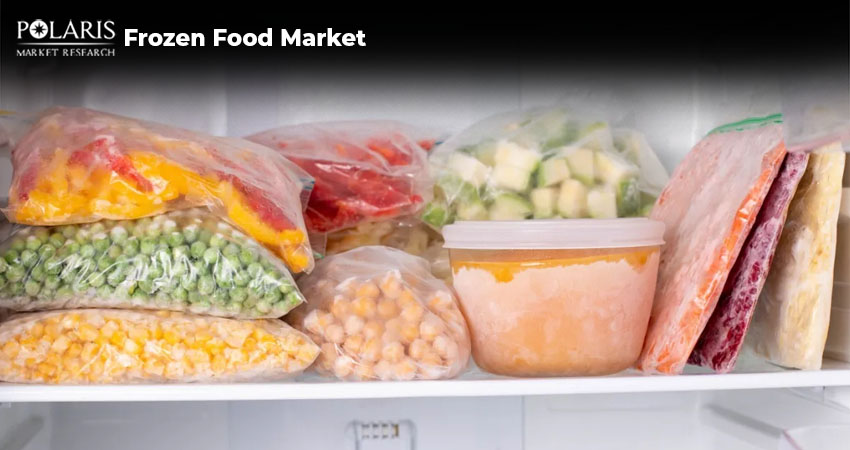Top 5 Companies Driving Transformation in the Frozen Food Market 2025

The frozen food market has grown significantly over the years, driven by evolving consumer lifestyles, increasing demand for convenience, and advancements in food preservation technology. The busy schedules of modern consumers have led to a surge in demand for ready-to-eat and easy-to-prepare meals, making frozen food a staple in households worldwide.
From frozen fruits and vegetables to full-course meals, frozen foods retain their nutritional value and offer extended shelf life compared to fresh produce. This blog explores the basics of frozen foods and their various types. Also, it highlights some of the major players driving transformation in the market. Continue reading!
Understanding Frozen Food
Types of Frozen Food
- Frozen fruits and Vegetables
Frozen fruits and vegetables are fruits and vegetables that have been frozen to preserve their nutrients and flavor. They are often picked at their peak ripeness and flash-frozen within a few hours of harvest. They offer a longer shelf life and are widely used in smoothies, soups, and side dishes.
- Frozen Meat and Seafood
Frozen meats and seafood are meats and seafood that have been frozen to extend their shelf life. The demand for frozen poultry, beef, pork, and seafood is increasing due to concerns over food safety and longer storage benefits. Many consumers prefer frozen over fresh meat because of its convenience.
- Frozen Dairy Products
Frozen dairy products are frozen desserts made from milk and milk products. They can include ice cream, frozen yogurt, frozen desserts, sherbet, and more. They are important because they extend shelf life, allow for year-round availability, and are a common food choice.
- Frozen Bakery Products
Frozen bakery products are pre-prepared baked goods that have been frozen to maintain their freshness and quality. They can include breads, pastries, cakes, muffins, pizzas, pies, and quiches. Frozen bakery products are important because they are convenient, versatile, and can be healthy. They can also help bakeries streamline production and improve efficiency.
Top Companies Offering Frozen Food Products
- Nestlé S.A.
Key Products: Hot Pockets, Stouffer’s
Established: 1866
Headquarters: Vevey, Switzerland
Nestlé S.A. is a multinational company that manufactures and markets frozen foods, as well as other food and beverage products. The company has been involved in the frozen food industry since the 1960s. Nestlé's brands include Nescafé, KitKat, Nespresso, Maggi, Toll House, and Milo. Nestlé focuses on innovation by offering healthier frozen meal options and expanding its plant-based product line.
Key Products: Reddi-Wip, Slim Jim
Established: 1919
Headquarters: Chicago, Illinois, USA
Conagra Brands is a public company that manufactures and sells processed and packaged food. Conagra Brands, Inc. is also major player in the frozen food market, with a strong position in frozen snacks and frozen food. The company is focused on growing its frozen food brands by tapping into consumer and restaurant trends. It has adapted to changing consumer preferences by offering organic and gluten-free frozen food options.
- General Mills, Inc.
Key Products: Häagen-Dazs, Pillsbury
Established: 1866
Headquarters: Minneapolis, Minnesota, USA
General Mills is a global food company that manufactures and markets frozen foods, including frozen dough, frozen breakfast items, and frozen entrees. The company started as a flour mill on the banks of the Mississippi River at Saint Anthony Falls in Minneapolis. It also make frozen hot snacks. General Mills focuses on innovation by introducing plant-based and protein-rich frozen food products.
Key Products: French fries, Hash Browns
Established: 1957
Headquarters: Toronto, Ontario, Canada
McCain Foods is a global leader in the frozen food market and has been a pioneer in India's frozen snacks sector. McCain Foods is also world's largest manufacturer of frozen potato products. The company helps minimize food waste for customers by using frozen technology to retain the quality of products for longer.
- The Kraft Heinz Company
Key Products: Ore-Ida, Bagel Bites
Established: 2015
Headquarters: Co-headquartered at
- Chicago, Illinois, USA
- Pittsburgh, Pennsylvania, USA
The Kraft Heinz Company was formed as a result of a merger of H.J. Heinz Holding Corporation and Kraft Foods Group. The company offers frozen foods like Delimex Crispy Quesadillas and Ore-Ida to meet the demand for quick and convenient meals. It also produces other foods for home, restaurants, and on the go. The Kraft Heinz Company continues to expand its frozen food portfolio by introducing healthier and organic options.
Emerging Trends to Look Out For
Plant-Based and Alternative Proteins: The rise of vegetarian and vegan lifestyles has fueled demand for plant-based frozen foods. Plant-based proteins are becoming more popular in frozen foods, including dairy, desserts, and plant-based meat. Companies like Nestlé and Tyson are investing heavily in this segment.
Health-Conscious Choices: Frozen foods that are more nutritious and convenient are becoming more popular as consumers are increasingly looking for frozen food options that are organic, gluten-free, and low in preservatives. Many companies are responding by offering healthier frozen meal choices.
Sustainable Packaging & Sourcing: A major trend in frozen food packaging is a strong shift towards sustainable options, including the use of compostable & biodegradable packaging materials, reducing plastic usage, sourcing responsibly, and incorporating smart technologies to provide transparency to consumers about the product's environmental impact.
To Sum It Up
The frozen food market is evolving rapidly, driven by changing consumer preferences and technological advancements. Leading companies are continuously innovating to offer healthier, sustainable, and convenient frozen food options. As the demand for frozen food continues to rise, companies will likely invest more in plant-based alternatives, eco-friendly packaging, and improved freezing technologies. With global expansion and increasing e-commerce presence, the frozen food market is set for steady growth in the coming years.

